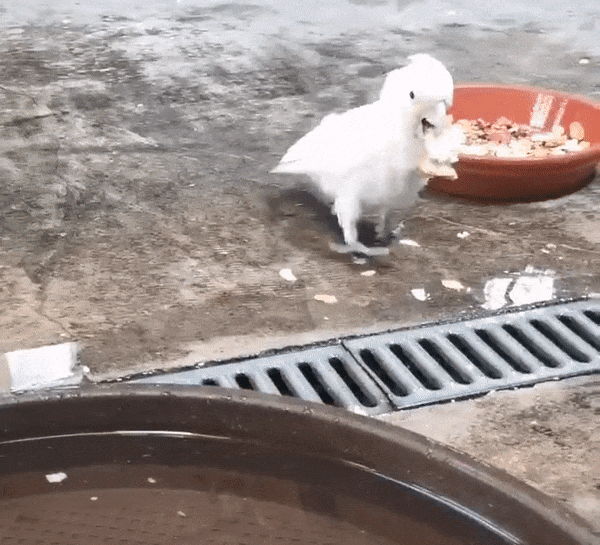Biology
Watch Cockatoos Dip Their Food in Water to Make It Soggy
A new study marks the first time that dunking behavior has been documented in parrots
Cats Prey on More Than 2,000 Different Species
A new study sheds light on just how many creatures domestic cats will eat—including hundreds that are threatened or endangered
Eels Can Genetically Modify Nearby Fish With Their Electrical Pulses
In laboratory experiments, gene transfer occurred in 5 percent of zebrafish larvae that were near eels when they discharged electricity
Rare White Alligator Born at Florida Wildlife Park
The baby gator, which doesn't have a name yet, was born with leucism, a condition that affects pigmentation
Here's What Can Cause Itchiness, According to New Research
Scientists discovered a connection between a bacteria linked to eczema and an itch-causing enzyme in a study of mice
See the First-Ever Photographs of a Rare Giant Rat That Lives Only on One Pacific Island
The elusive and critically endangered Vangunu giant rats are at least twice the size of common rats
African Penguins Tell Each Other Apart by Their Polka Dot Patterns
New research suggests the birds may find their mates in crowded colonies by looking at their chest plumage
A New Drug That Could Extend Dogs' Lives Inches Closer to Approval
For the first time, the FDA has indicated a willingness to endorse a longevity drug
This Bat Uses Its Extra Long Penis Like an Arm While Mating
Serotine bats are the first mammals known to mate without penetration, new research suggests
Metal Pollution May Be Making More Green Sea Turtles Female
In addition to warming temperatures, new research finds contaminants might contribute to the endangered reptiles' skewed sex ratios
Here's What Causes Fainting, According to New Research
Scientists have discovered a pathway between the heart and brain in mice that appears to be involved during loss of consciousness
Watch How Hummingbirds Fly Through Narrow Spaces
Slow-motion video revealed the birds take two different approaches: flying sideways or pinning their wings back and darting like a bullet
Cheetahs Become More Nocturnal in Extreme Heat, Study Finds
Hunting later at night may force the big cats to surrender their prey to larger carnivores, such as lions and leopards
How Kingfishers Dive Head-First Into Water Without Getting Concussions
Thanks to a new genetic analysis of 30 kingfisher species, researchers are one step closer to understanding the birds' dramatic hunting style
Rats Can Use Imagination to Navigate in Virtual Reality, Study Finds
Like humans, the rodents appear to be able to visualize walking through locations they've previously visited
Engineers Create 'Air Conditioning' for Salmon With Chilled Patches of River Water
Wild Atlantic salmon can struggle with heat as they swim upstream to spawn—but artificial "thermal refuges" may help them cool off
The Ecological Benefits of Rehoming a National Park's Booming Bison Population
In Theodore Roosevelt National Park, staffers are keeping the local ecosystem in balance by sending 300 bison to Native American tribes
Genetically Modified Silkworms Can Produce Spider Silk That's Stronger Than Kevlar
The sturdy, biodegradable fibers could one day be used for surgical sutures or armored vests
How Do Cats Purr? Scientists May Now Have an Answer
Domestic cats produce low-frequency vocalizations when purring, an unusual ability for their small size
Viruses Found in Animal Poop May One Day Treat Diabetic Foot Ulcers, Scientists Say
Known as bacteriophages, the specialized viruses could hijack and kill drug-resistant bacteria
Page 5 of 85

:focal(960x640:961x641)/https://tf-cmsv2-smithsonianmag-media.s3.amazonaws.com/filer_public/f6/f3/f6f3493a-467f-4474-8c52-af5d021414b6/cat-5778777_1920.jpg)
:focal(1060x706:1061x707)/https://tf-cmsv2-smithsonianmag-media.s3.amazonaws.com/filer_public/2d/32/2d32e43f-aa3c-4339-8d67-e762196845be/gettyimages-174522285.jpg)
:focal(1440x960:1441x961)/https://tf-cmsv2-smithsonianmag-media.s3.amazonaws.com/filer_public/53/43/5343a46c-66e4-4f8e-8f6e-ab731ad69793/leucistic_2.jpg)
:focal(400x267:401x268)/https://tf-cmsv2-smithsonianmag-media.s3.amazonaws.com/filer_public/45/b8/45b8d233-f443-4a76-a170-3464ef094741/gettyimages-1573800978.jpeg)
:focal(400x267:401x268)/https://tf-cmsv2-smithsonianmag-media.s3.amazonaws.com/filer_public/8f/0f/8f0f0308-7fc3-4a04-978f-2d665d277d5d/large.jpg)
:focal(790x526:791x527)/https://tf-cmsv2-smithsonianmag-media.s3.amazonaws.com/filer_public/6e/15/6e158b03-356d-4290-ad69-b61c7226e72f/1-s20-s0003347223002579-gr1_lrg.jpg)
:focal(1061x707:1062x708)/https://tf-cmsv2-smithsonianmag-media.s3.amazonaws.com/filer_public/02/43/024336e0-bdf4-44f3-ac35-238102b81df2/gettyimages-1317511160.jpg)
:focal(1944x1296:1945x1297)/https://tf-cmsv2-smithsonianmag-media.s3.amazonaws.com/filer_public/0b/de/0bde47ff-5a50-401d-bf11-4915dd96fa69/photo_of_a_serotine_bat_3_credit_alona_shulenko.jpg)
:focal(4330x2887:4331x2888)/https://tf-cmsv2-smithsonianmag-media.s3.amazonaws.com/filer_public/a1/f8/a1f8cbd5-f98b-488b-ad2e-28075e19c97e/gettyimages-1468364722.jpg)
:focal(1063x708:1064x709)/https://tf-cmsv2-smithsonianmag-media.s3.amazonaws.com/filer_public/92/4d/924df39c-4961-4fc5-b7a6-46768e8d7194/gettyimages-200344289-001.jpg)
:focal(867x562:868x563)/https://tf-cmsv2-smithsonianmag-media.s3.amazonaws.com/filer_public/28/04/28047578-43cf-4989-89ab-2219f0211797/hummingbird_2000px.jpg)
:focal(1004x751:1005x752)/https://tf-cmsv2-smithsonianmag-media.s3.amazonaws.com/filer_public/15/c7/15c750bd-6553-474d-b50a-729d5a0486c8/33548972384_ba0366f94e_k.jpg)
:focal(1640x1093:1641x1094)/https://tf-cmsv2-smithsonianmag-media.s3.amazonaws.com/filer_public/20/c7/20c74bbf-c59b-45dc-8899-fbda43b70d48/gettyimages-1068204378.jpg)
:focal(2088x1392:2089x1393)/https://tf-cmsv2-smithsonianmag-media.s3.amazonaws.com/filer_public/74/b5/74b597f6-5e9d-464c-a72b-1e55c244613d/pexels-denitsa-kireva-14595471.jpg)
:focal(1031x732:1032x733)/https://tf-cmsv2-smithsonianmag-media.s3.amazonaws.com/filer_public/4a/41/4a41a0e2-f577-48ea-a110-1e8923ef275f/gettyimages-1374937713.jpg)
:focal(2456x1380:2457x1381)/https://tf-cmsv2-smithsonianmag-media.s3.amazonaws.com/filer_public/87/e9/87e9f381-ab34-477f-8155-b47980196535/95782f80-1dd8-b71b-0bf3e3052c5b2764original.jpg)
:focal(1728x1747:1729x1748)/https://tf-cmsv2-smithsonianmag-media.s3.amazonaws.com/filer_public/4e/5d/4e5ddd18-2198-4c22-be82-2e26fbc0ea9c/silk_fibers_produced_by_transgenic_silkworms_credit_junpeng_mi.jpg)
:focal(960x690:961x691)/https://tf-cmsv2-smithsonianmag-media.s3.amazonaws.com/filer_public/22/bb/22bb49ea-0c7f-411f-a5f5-757f63eec8f4/cat-4189697_1920.jpg)
:focal(640x366:641x367)/https://tf-cmsv2-smithsonianmag-media.s3.amazonaws.com/filer_public/71/3d/713d0cb9-6d93-4e0e-8376-8ed3abf1245e/ywp_lemurjpg.jpg)